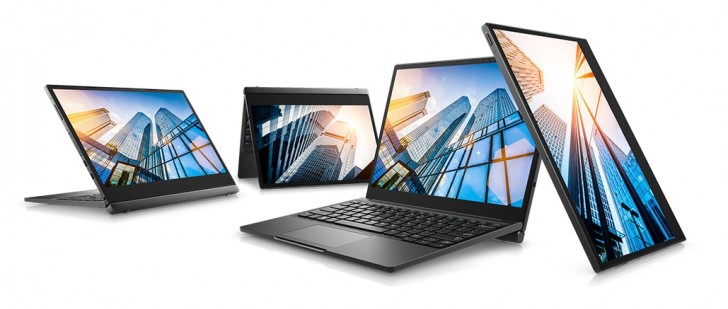Technology
Dell Launches World’s First Wireless Charging Laptop

Here are the facts about Dell Launches World’s First Wireless Charging Laptop.
On Tuesday Dell announced its Latitude laptop 7285, which is the first wireless charging laptop in the world. It’s charging features added an extra cost.
Table of Contents
Cost:
The company told that the latitude laptop 7285 12 inch is available on the website at a cost of $1,199.99 and the cost of wireless charging keyboard and mat is about $549.99.?
Is Dell Launches World’s First Wireless Charging Laptop?
Starbucks to upgrade charging pad to support iPhone X
Dell launch first wireless charging laptop. It has many benefits. It has many amazing features in it. It does not mean it is charge without any charger it also need a charging mat where it put to charge.

It is the same idea to wireless charging smartphones, where you can wirelessly charge a smartphone onto a mat.This concept is not much benefit, still, you will need to charge laptop where the wireless charging mat is placed.
Don’t use on a metal surface:
The charging mat is not designed to be used on a metal surface as the technology involves magnetism. You will need to place it on a 2-inch non-metallic stand to use wireless charging mat on a metal surface.

Specification:
The latitude 7285 12-inch 2 in 1 regarded as a typical type slab. The PC’s Intel Core i5 or Core i7 Cpu, 128 GB or 256 GB SSD, 8 or 16 GB of memory, 2880×1920 touchscreen that can be detached from the keyboard so you can also use it as a tablet.
Nvidia turn out to be the smartest company of 2017
This wireless charging device is not quite the wireless future but it is a step in that direction.
Advantages of this wireless laptop:
It has several advantages such as:
- It does not contain cable which may be reason of mess when you use a laptop because there is also a need of putting laptop on charger when you work on laptop then there will be a mess which create by cables charger.
- It is easy to carry. You can easily use laptop and easily charge laptop anywhere.
Conclusion:
In the world of technology, there is hope and chances of charger should be wireless. Because technology rapidly changes and it provide us many benefits which makes our task easy.

A blog which focuses on business, Networth, Technology, Entrepreneurship, Self Improvement, Celebrities, Top Lists, Travelling, Health, and lifestyle. A source that provides you with each and every top piece of information about the world. We cover various different topics.
Technology
Sealing the Deal: How to Choose the Right Materials for Pipe Sealing

Pipes are an essential part of any plumbing system, and keeping them in good condition is crucial for the overall functionality of your home. One way to ensure that your pipes stay in top shape is by properly sealing them with the right materials.
In this guide, we will discuss the different types of materials used for pipe sealing and how to choose the best one for your specific needs.
Table of Contents
Understanding Pipe Sealing
Before we dive into the details of materials for pipe sealing, it’s important to understand what pipe sealing actually means and why it is necessary.
Pipe sealing is the process of closing off any gaps or leaks in pipes to prevent water or gas from leaking out. This can be done for various types of pipes, including water supply pipes, drainage pipes, and gas pipes.
Proper pipe sealing not only prevents the wastage of resources but also protects your home from potential water damage and gas leaks.
Types of Pipe Sealing Materials
There are a variety of materials available for pipe sealing, each with its unique properties and uses. Some common types include:
Teflon Tape
Also known as plumber’s tape, Teflon tape is a thin, white tape made from PTFE (polytetrafluoroethylene) that is commonly used for sealing threaded pipe connections. It provides a tight, leak-proof seal and can withstand high temperatures and pressures.
Pipe Dope
Pipe dope is a paste-like substance made of oils, resins, and mineral fillers that is applied to the threaded part of pipes before they are connected. It creates a seal that is resistant to vibration and pressure fluctuations, making it a great choice for high-pressure systems. Unlike Teflon tape, which can be used only on threads, pipe dope can be applied to any connection needing a waterproof seal.
Pipe Plugs
Pipe plugs are physical barriers inserted into the ends of pipes to stop the flow of water or gas temporarily. They are often used during maintenance or repair work to isolate a section of the plumbing system without shutting off the entire system. Pipe plugs can be made from various materials, including metal, rubber, and plastic, each designed to withstand different pressures and temperatures. Knowing when and how to use pipe plugs effectively is crucial for anyone working on plumbing systems, as they provide a quick and easy solution for controlling the flow within pipes.
Choosing the Right Materials for Your Needs
Now that you understand the different types of materials used for pipe sealing, how do you choose the right one for your specific needs? Here are a few factors to consider:
Type of Pipes
The first thing to consider is the type of pipes in your plumbing system. Different materials may be better suited for certain types of pipes, so make sure to choose one that is compatible.
Type of Connection
The type of connection also plays a role in determining the right sealing material. For threaded connections, Teflon tape or pipe dope would be suitable, while pipe plugs are ideal for temporarily blocking off non-threaded connections.
Pressure and Temperature
The pressure and temperature within your plumbing system should also be taken into account. Make sure to choose materials that can withstand the levels of pressure and temperature within your pipes.
Reliability and Longevity
Lastly, consider the reliability and longevity of the sealing material you choose. You want a material that will provide a long-lasting seal to prevent any future leaks or problems.
Conclusion
Proper pipe sealing is essential for maintaining a functional plumbing system and protecting your home from potential damage. By understanding the different types of materials available and considering key factors, you can choose the right material to ensure a tight and lasting seal for your pipes. Remember, when it comes to pipe sealing, it’s always better to be safe than sorry. So take the time to choose the right materials and ensure the longevity and efficiency of your plumbing system.

A blog which focuses on business, Networth, Technology, Entrepreneurship, Self Improvement, Celebrities, Top Lists, Travelling, Health, and lifestyle. A source that provides you with each and every top piece of information about the world. We cover various different topics.
-

 News2 weeks ago
News2 weeks agoBlaze ravages apartment complex in Lomita
-

 News2 weeks ago
News2 weeks agoChina’s Communication Satellite is Orbiting the Moon
-

 News2 weeks ago
News2 weeks agoBay Area cancer patient freezes eggs in hopes of future family, but lacks funds for IVF treatment
-

 Entertainment2 weeks ago
Entertainment2 weeks agoDoja Cat claps back at fans criticizing her natural hair
-

 News2 weeks ago
News2 weeks agoIndia’s Silicon Valley Faces Water Crisis
-

 News2 weeks ago
News2 weeks agoTrapped in Baltimore: The Struggle of the Crew Caught in Steel
-

 News2 weeks ago
News2 weeks agoLawyers Turn to Defamation Lawsuits to Combat Political Disinformation
-

 News2 weeks ago
News2 weeks agoAnimal Blessing Ceremony Captured in Photos on Olvera Street


























